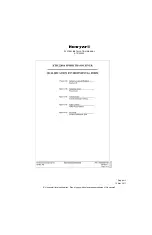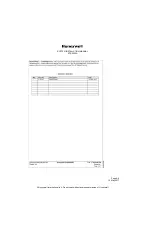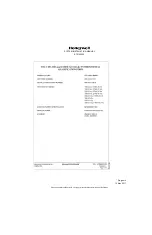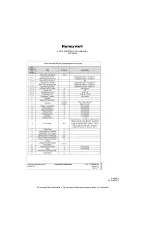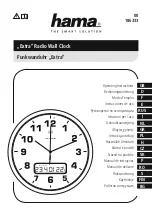
SYSTEM INSTALLATION MANUAL
KTR 2280A
Page 2-47
15 May 2017
© Honeywell International Inc. Do not copy without express permission of Honeywell.
rose location is a good choice since magnetically “clean” is one of the criteria for estab-
lishing compass rose location.
NOTE:
Ensure that QE = 0 is the value being fed or the last value that was fed to the KTR
2280A before performing this procedure.
1. Point the nose of the aircraft directly at the emitter (NDB or AM broadcast radio station)
being used for this purpose. Confirm this orientation by verifying the ADF indicator’s
bearing pointer is pointing directly to the lubber line (aircraft nose reference).
2. Record the magnetic heading of the aircraft using the aircraft directional gyro or mag-
netic compass.
3. Using the aircraft’s directional gyro or magnetic compass as a guide, rotate the aircraft
45
°
to the left such that the aircraft magnetic heading is now 45
°
less that the value
found in Step 2.
4. Record the number of degrees by which the ADF bearing has moved relative to the
ADF indicator’s lubber line. (This number must be a positive number and must be ap-
proximately 45
°
.) Log this number as Bearing_45.
5. Using the aircraft’s directional gyro or magnetic compass as a guide, rotate the aircraft
another 45
°
to the left so that the aircraft magnetic heading is now 90
°
less than the
value found in Step 2.
6. Record the number of degrees by which the ADF bearing indication has moved relative
to the ADF indicator’s lubber line. (This number must be a positive number and must
be approximately 90
°
.)
7. Confirm that the value in Step 6 is within ±5
°
of 90°. If not, the aircraft has a magnetic
anomaly that precludes the ability to calculate an acceptable QE adjustment The QE
alignment process must terminate at this point and not resume until any aircraft related
anomalies have been corrected. (Note: Problems with this step could also be due to the
airfield location where the QE alignment procedure is being performed if that location
is not magnetically “clean”.)
8. Using the aircraft’s directional gyro or magnetic compass as a guide, rotate the aircraft
another 45
°
to the left so that the magnetic heading is now 135
°
less than the value
found in Step 2.
9. Record the number of degrees by which the ADF bearing indication has moved relative
to the ADF indicator’s lubber line. (This number must be a positive number and must
be approximately 135
°
.) Log this number as Bearing_135.
10. Using the aircraft’s directional gyro or magnetic compass as a guide, rotate the aircraft
another 45
°
to the left so that the aircraft magnetic heading is now 180
°
less than the
value found in Step 2.
11. Record the number of degrees by which the ADF bearing indication has moved relative
to the ADF indicator’s lubber line. (This number must be a positive number and must
be approximately 180
°
.)
12. Confirm the value recorded in Step 11 is within ±5
°
of 180°. If not, the aircraft has a
magnetic anomaly the precludes the ability to calculate an acceptable QE adjustment.
The QE alignment process must terminate at this point and not resume until the aircraft
related anomalies have been corrected. (Note: Problems with this step could also be
due to the airfield location where the QE alignment procedure is being performed if that
location is not magnetically “clean”.)
13. Using the aircraft’s directional gyro or magnetic compass as a guide, rotate the aircraft
another 45
°
to the left so the aircraft magnetic heading is now 225
°
less than the value
found in Step 2.
14. Record the number of degrees by which the ADF bearing indication has moved relative
to the ADF indicator’s lubber line.
(This number must be a positive number and must be approximately 225
°
.) Log this
number as Bearing_225.
15. Using the aircraft’s directional gyro or magnetic compass as a guide, rotate the aircraft
another 45
°
to the left so that the aircraft magnetic heading is now 270
°
less than the
value found in Step 2.



























